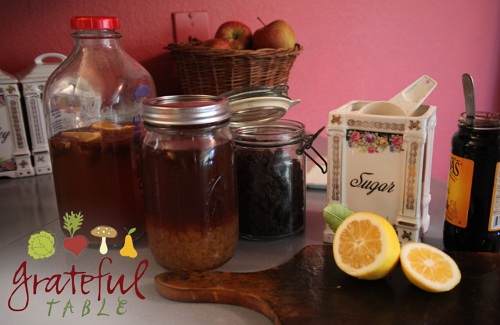My absolute favorite “soda” recipe for water kefir is this Orange Kefir Recipe. Though I’ve tried all kinds of flavors/juices/etc., the orange kefir recipe is the most successful for extra fizz and deliciousness. Oh, plus there are extra nutrients in orange rind, so… yeah!
Update, April, 2024: My kefir’s been going strong for almost ten years now! At one point, I had given some to a friend, and she had to give me some of hers when mine died. I hadn’t realized my Berkey filter needed replacing (the resulting chlorine killed mine off that time). Pure, filtered water can make all the difference for delicate probiotic critters.
Also, partway into this kefir venture, I discovered another helpful tip: Add an 1/8 tsp. baking soda every other time, and your grains will be extra happy.
I found they also get depressed when I’ve fed them regular “Grandma’s Molasses”, as it’s not organic, and doesn’t contain nearly as many nutrients as organic blackstrap. My grains had started getting tinier and tinier; when I switched back to the organic, they resumed their bouncy, fluffy-big demeanor. I think this says something to us about how nutrient-dense foods can really impact our health for the good as well.
 Get some grains from a friend, or buy some water kefir grains from Amazon. Just don’t use milk-kefir grains. These are NOT the same thing!
Get some grains from a friend, or buy some water kefir grains from Amazon. Just don’t use milk-kefir grains. These are NOT the same thing!
Spring water is best- chlorine will slow down (or kill) your grains. Also, don’t use honey. It is anti-bacterial, so it can slow the culture down (or stop it dead in its tracks).
I tried organic raw sugar, but after a month of that, my grains died. Coincidence? Not sure, but now I like to use a blend of half refined white sugar and half palm sugar (100% palm sugar seemed to turn out weird).
Oh, and never add fresh pineapple to the first ferment; one woman posted that her grains got irreparably damaged. Maybe it’s the extra enzymes in the pineapple? I’m not going to use pineapple.
Making water kefir is a fairly easy process, with just a little daily maintenance. After the kefir grains convert their food supply to probiotics (within a day or two), add them to a fresh jar of sugar/molasses water. You can tell by tasting the brew after the first 24-48 hours- if still sweet, you can let it ferment for another day or two, before bottling it for the second ferment.
Kefir Management (Buying Yourself Some Time)
Give yourself (and the grains) a vacation- the grains appreciate a little bath now and then anyway. Just drain off the sugar/water into a bottle, and add the grains back into their fermenting jar; cover with filtered water (unsweetened). Store these water-bath kefir grains in the fridge for a week or two, to the benefit of all.
Another trick: When getting bogged down with extra kefir, throw out all but two tablespoons of the grains. It takes longer for fewer grains to eat through the sugar water. (The more grains you have, the more quickly they eat through a new batch of sugar water.)
A friend tried refrigerating her grains in a strong sugar syrup so she could (hopefully) ignore them for months. The grains gradually multiplied to practically fill the whole jar. But they ate through every last bit o’ sugar/molasses that the water contained. And then… they died. They looked all right, but they had essentially gotten preserved in that jar like pickled brains or something. Looking prolific, but… dead!
The grains multiply; put the extras in the compost pile, or give to a friend (or even eat them?), or just throw ’em out. More will be created! Note: I discovered that our son’s dogs LOVE kefir grains, so they’re the clean-up crew for any extra grains when they’re around.
INGREDIENTS
- 1/4 c. sugar (not raw, but refined white sugar, or half white/half palm sugar)
- 2 tsp. molasses (organic blackstrap makes the grains so happy)
- 1 slice lemon (optional)
- 4 c. Spring water (filtered, non-chlorinated)
- Kefir grains (1/4 to 1/2 c., more or less)
PREPARATION
1. Fill a quart jar with: > 1/4 c. white sugar > 2 tsp. molasses > 1 slice lemon (Optional) > 3-4 c. spring water (leaving space at the top for adding the grains)
2. Add lid and shake jar vigorously until sugar and molasses are mixed in.
3. Add rinsed kefir grains, cover with a lid.
4. Let mixture brew for 1-3 days, until not-so-sweet, but fermented.
5. For a second ferment, where carbonation will build up, making it like soda, drain brew into bottles with ceramic stoppers. See below for “Preparation for 2nd Ferment”.
6. Add the strained-out grains to fresh jar of sugar/molasses water, repeat steps. (As grains multiply, discard some as necessary, or give to friends.)
INGREDIENTS FOR 2ND FERMENT
- Handful of dried fruit (raisins or other), or fresh fruits or juices
- Other spices if desired (fresh sliced ginger, organic orange peel, vanilla, tamarind, etc.)
- Optional: Favorite fruit juices or concentrates (fresh-juiced make the ferment go bonkers- super bubbly!)
PREPARATION FOR 2ND FERMENT
1. Into a clean 32-oz. bottle (or jar), decant the brewed kefir water, straining out the kefir grains, leaving space for other ingredients.
2. Add a small handful of favorite dried fruits (or experiment with fresh fruits), or use a cup or so of juice.
3. Optional: Add other flavorings if desired ( fresh ginger, organic orange peel, etc.),
4. Optional: If you add non-sweet flavorings like ginger, vanilla, or orange peel, you can actually add honey (or sugar) to this mix to give the kefir something to feed on, to make the brew extra tasty and extra fizzy. Although I don’t add honey to the kefir grains in the first ferment, it seems to work in the second ferment. Use organic honey if possible!
4. Let ferment another day or two, with lid or cap on. Check the bottle after a day or so (if you have the Grolsch-type bottle with resealable cap), to see if it’s fizzy enough. Refrigerate after about one or two days. Will keep for a couple weeks, refrigerated. Remove lid with care (over the sink, with hand over it, as it may become quite bubbly)!
5. Certain glass bottles can be reused (if they’re the kind you use a bottle-opener on); just get this to hold in the fizz. Or buy something like Grolsch beer, with its ceramic/rubber seal stopper, and reuse that. My fave are these Cobalt Blue 32 oz. Bottles; they’re sturdy, and are “family-size”, which is nice! (Some note that the blue glass protects against fluorescent rays also, which may/may not be an issue…)
I’ve linked this post to Kelly the Kitchen Kop’s “Real Food Wednesdays”; check out the other great links she’s listed, HERE!
I’ve also linked this post to My Humble Kitchen. Check out Diana’s page, “Simple Lives Thursday“, for more great ideas.
PS You might want to print up this simplified copy of the directions, below.


3 Responses to “Kefir: Non-dairy Water Kefir- Easy, Simple Directions”